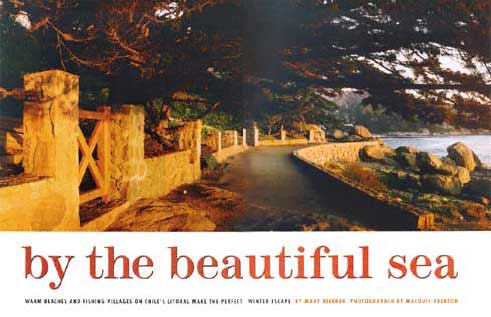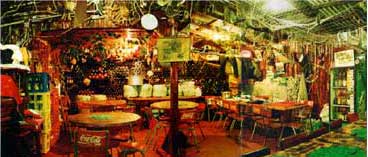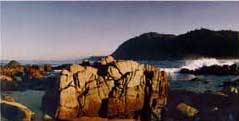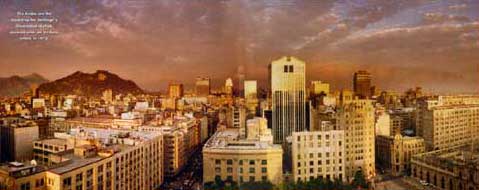| Artwork | Index | Editorial Writing | |
| Books | About | Links |
| Mary Heebner |
|
Travel Holiday |
|
 |
Chile is rapidly becoming South America's hottest tourist destination and many North Americans are discovering its diverse and sophisticated culture for the first time. On the flip side of the Equator, Chile's profile mirrors the Pacific corridor from Baja to Juneau. The further south one ventures, the more reminiscent Chile is of the US. Northwest's forest and lake lands, a sport fishers' paradise. The terrain thins out to a series of islets, perforations in the icy blue lace of glacial waters in Patagonia and the Tierra del Fuego frontier. To the north, correlate in latitude to the tip of Baja California, are traces of the ancient Inca terraces buried beneath the parched Atacama Desert, a place where time is nothing more than a slow hot wind. Chile's rich Criolla heritage, a melding of native and colonial sensibilities, is infused with American pop culture. This confluence of old and new made my husband and me curious about what makes Chile distinctly exciting. Catching the heat and light of a second summer made a winte'═s sojourn to Chile a temptation impossible to resist. Chile is unique. Tucked below the continent's bulging left hip that contains Peru, Ecuador and Colombia, it is |
geographically isolated from the rest of South America by the longest mountain range in the world. The great earthen curtain of the Andean Cordillera, towering 19,000 feet in places, was a sea bed that was thrust up between Chile and the rest of South America 80 million years ago. Snow melt gathers into great river systems which nourish the fertile Central Valley, bounded on the west by the eons older Coastal Range, before spilling into the Pacific. This is analogous to California, yet to picture Chile's anorexic proportions one must understand that Chile's length is one tenth of the Earth's perimeter, it averages 106 miles wide, and the entire 2600 mile long country shares the same time zone. Santiago, at Chile's navel, is home to over one third of it's 13 million people. After a fourteen hour flight we decide to pamper ourselves for a few days in Santiago's Sheraton San Cristobal and explore the city before making the two hour drive to the Litoral coast. Off season, when the valley's inversion layer has lifted, Santiago sparkles beneath the snow covered Andes. From the rooftop garden of the venerable Hotel Carrera we have a bird's eye view of Palacio de la Moneda, Chile's White House, which faces the Plaza de la Constitución. As late summer sun bounces off glassy skyscrapers they become light-catchers, aquamarine mirrors that throw a reflection of the city back on itself. The Neoclassic architecture is minimal, colorless, and as graphically clean as a Cubist painting. The Santiaguino architectural palette includes wood that darkens with each polishing, concrete the color of claysilt, bold blackened wrought iron, and Atacama copper that is a weathered sea green or bright as Icarus. |
|
| Two arms of the Rio Mapocho embrace the city's core. One branch of this river was filled in to become the Avenida Bernardo O'Higgins. The remaining branch of the river is corseted in concrete and collared in green. This European-styled greenbelt, Parque Forestal, edges the Mapocho. Lovers rest on shaded park benches. Contemporary sculpture and man-on-horse statues are plopped like markers across the landscape. Shaggy dreadlocks of willows drag along the banks where tulips and irises are about to bloom. In the center of the long park is the Palacio de Bellas Artes. It houses both traditional and contemporary fine arts collections and has just reopened its doors in March 1995 after majorstructural restoration. The massive faceted skylight in the central hall is a jewel. The poignant, political art on display in the contemporary wing is evidence enough that Chile's eighteen years of dictatorship has yielded to a more democratic voice. The Museo Chileno de Arte Precolumbiano is nearby the Plaza de las Armas, the downtown nucleus of the old colonial city that is still a popular gathering spot. |
 |
The informative, beautifully installed collections of Andean indigenous pottery, sculpture, and textiles are ranked among the world's best exhibitions of Pre-Hispanic art. There are distinct neighborhoods well worth exploring; Bellavista's brightly painted buildings, artist's studios, and street vendor stalls segue in the evening to theater, nightclubs open till dawn, and Mediterranean Tascas where disenchanted poets talk in low tones over cups of deep red wine. Providencia began as a small convent/orphanage run by the Sisters of Providence on the outskirts of a town that has grown to absorb it. Parisian style outdoor cafes now pepper the tree-lined shopping avenues and some of the old Criolla houses are converted as offices, creating an interesting mixed-use neighborhood. Fair and helpful taxi drivers and a remarkably spotless Metro made getting around town quite simple. We waited until leaving for the coast to rent a car. The sixty mile stretch of central coast called the Litoral is a year-round weekend get-away destination for many Santiaguinos. Most summer tourists are South Americans who vacation here in January and February. Off-season begins in March. These are the only two zones in the entire Western Hemisphere with a Mediterranean climate, the central coasts of California and Chile. In both places pelicans dive bomb into clouds of anchovies, sand dunes gather at river mouths lined with willow and juncus and a well maintained curvaceous highway parallels the ocean. We pick up our car, take Route 68 west, stopping only once. We buy the sweetest peaches at one of the many family run roadside stands along the highway, which I peel, and hand feed to Macduff as he drives – a trail of juice dots the Turistel map spread over my lap. The road signs are easy to follow and the air is thinning towards Fall. We've decided to base ourselves in Zapallar, and take daily outings to the different caletas and beaches that are well marked in our Turistel guide. A caleta is a fiserman's cooperative, a building or locale near a beach or a shell-strewn cove. It is a way of life that has survived for centuries. If the heart of a home is its kitchen, the heart of a coastal town is its caleta. Our first glimpse of the coast is the bay between Viña del Mar resort and the industrial port of Valparaiso. Viña is one of the oldest resorts or balnearios in the Litoral and by far the best known. One hundred years ago magnificent estates – second homes for wealthy Chileans – surrounded by large gardens, were spaced generously apart in this valley and Viña del Mar became known as "The City of Gardens". Viña evolved from its hacienda days into a get-away resort. The malecón, a boardwalk hemmed by immaculately kept flower beds, is still the place to be seen en promenade. Viña has now grown into a full-fledged city. For those seeking theater, nice restaurants, a Thirties era Casino, and night life that sizzles like rain on a wire, Viña is less than an hour's drive away from the Zapallar-Cachagua-Papudo area in the north. But we're in search of a quieter, slower paced rhythm and are happy to continue up the coast past the crowded beach scene and the thousands of condos literally stacked like stairs of a stadium along the Viña-Reñaca strip. Our destination is the elegantly comfortable Isla Seca Hotel in Zapallar. Zapallar is a hacienda-spawned resort or balneario that has settled more harmoniously into its habitat. In the early 1900's Don Olegario Ovalle Vicuña parceled out some of his hacienda to friends he wanted to have as neighbors.
|
|
But the deal was that they had to build within two years, so that a concern for an overall plan superseded each person's individual dream house. A network of winding streets, a charming central plaza, tall cypress, eucalyptus and pine trees, and colorful fantastic gardens, defined Zapallar – an American interpretation of late 19th century French Riviera high life. The bay is like a large, round-bottomed gourd that is continuously filled and emptied. Growers dubbed this site "Zapallar" because it was a fine place to grow gourd squash (zapallos). In the 19th century much of the Litoral was owned by a few powerful families who farmed the land. The manor houses of these landed estates were set back from the sea. The creation of a national merchant fleet of small sailing vessels in 1830 prompted the owners to build warehouses right on the shore next to the old caletas where fishermen kept their boats. This allowed farm products to be shipped directly from the hacienda. Invited guests who craved a taste of salt-fresh air and a simple bunk heralded the beginning of tourism. Small adjacent caba°as gradually upped the warehouses to the status of a manor house and vacationing seaside became a fashionable escape from the heat of Santiago in summer. The caletas remain pretty much the same, only now, beside or above most, are outdoor market/restaurants, chiringuitos, which sell the morning's catches or serve them accompanied by excellent Chilean wine. |
  |
La Rambla is a winding path that traces the contour of the bay. At sunset coppery light glances the beachward side of a stand of cypress whose branches crosshatch the sky. Just beyond the Rambla, girded with hand hewn sandstone walls, is pure ocean, breathing blowholes, blasting the ragged cliffs, shaping granite into cue balls. Isla Seca, namesake of our hotel, is a barren bird-whitened promontory. At the opposite end of the bay from Isla Seca point is a hill where cactus, ice plant, and daisy-like coreopsis are cat's cradled with footpaths and dusted with fog. At dusk, a cuticle of moon slowly appears above that hill in a faded yellow sky. We watch until the water turns to slate. The next morning at eight I am the first to disturb the rake marks on the Rambla, walking around the bay to the tide pools near the fisherman's caleta, curious about the unfamiliar shellfish I have seen or eaten. I know crab, oyster, mussel, but what are these strangely delicious others? I walk up to an older fisherman and place a handful of shell bits in his small callused hands. He gestures for me to follow. A gastronomic biology lesson among the rocks. "Loco," he presents an algae stained cup-shaped shell with a curled lip, that he says is very rare now. He says, "Lapa" and hands me a shell that looks like an overgrown limpet. Lapa is an algae feeder like the abalone and, unlike the similar tasting loco, can be cultivated in hatcheries. "Erizo," the urchin familiar to me as uni in sushi bars, is a delicacy that tastes like sea foam ought to. Segundo Malacuso has fished here all his life. He crashes about the shell strewn rocks in sturdy rubber boots, pulling, tugging at his latest specimen, a pico roco, my absolute favorite. The white flaky meat of this hefty volcanic-shaped barnacle, when steamed, tastes like tender crab surrounded by a mousse-like custard. Ever since trying pico roco in San Angelmó, in the south of Chile three years ago, I have craved it. Don't leave Chile without tasting it. Another fisherman strong-arms a weighty net bag of machas clams, that he had stowed in the pools earlier, up to be shucked then steamed. This is Segundo's task and so he follows. Behind the chiringuito a warren of men keep warm and silently sip tea around a fire. Here, I am an intruder. I wave a thanks to Segundo and jog back to the hotel in time for some steamy espresso and biscuits and a morning swim in the pool that overlooks the frigid ocean. The guests include a Canadian family of four, an American couple visiting their son who has relocated his computer graphics business to Santiago, and two svelte Italians on their honeymoon. After breakfast we walk through the quiet town. A little girl skips circles around a nattily dressed grandfather leaning on a carved wooden cane. We meander at a snail's pace through beautifully kept old neighborhoods, listen to the scrape and clip of gardeners at work behind a mossy, thick stone wall, and smell late summer blossoms that merge with the perfume of ripe fruit for sale at the corner market. Crisp autumn light gilds a hawk's wing as she banks seaward. I'm beginning to realize what a best kept secret the off-season is along Chile's Litoral. A five minute drive south takes us to Cachagua. Playa Cachagua is a beach walker's delight. A chalk stroke in the flat distance is all that's discernible of the ten foot spume at the farthest end of the horizon. Two boys with plastic lime green buckets inspect rock crannies for crabs. A mosaic of hundreds of black and purple mussels poke up out of the sand like an unearthed Roman floor. Traces of mica glitter golden on the coarse umber sand. Four tourists led by a young wrangler bobble up the beach on fast trotting horses. Rock-hopping and sprayed with surf, we reach Playa de las Cujas, a rugged corral of rocks sheltering a calm inlet of water that made me wish I'd brought my snorkel and mask.
A Santiaguino couple recommended that we drive to Higuerillas cove for a caltea -style meal. It's about thirty miles south of here and we soon join other interested landlubbers who assess the day's catch from the boardwalk above. At the water's edge, ten men heave-ho with the wave break to bring in the boats while a coterie of pelicans scramble for fish scraps. Names are painted on the prows of wooden fishing boats trimmed in bold colors: Mira Como Voy, Sangra Paulina and Mamita Tita. Beneath a shaded lean-to a man slides the blade of his knife along the spine of a reinata, flicks off the fins, and in seconds, parts its narrow body and gently filets it. The Mar Azul restaurant perches like an outgrowth of the pier itself above the caleta. We order reineta a la plancha con ajillo, ( sole grilled with garlic) chased with a cold Austral beer. Sailboats just finishing a regatta course head back to the Yacht Club on the other side of the breakwater. Hearty aromas, from the caleta below the restaurant, of cazuela (fish stew) boiling in a huge paila pot, funnel upward. Men stand around, drinking spiked juice from green melons split with the whack of a machete. They await wives, kids and girlfriends for a Sunday afternoon fiesta. Now we're hooked on seeking out more caletas. I'm drawn to the soulful and direct way of life we witness. After lunch we wind our way back up the coast, taking detours down to other fishing caletas along land's edge. So much business is transacted in the sand. I am standing on kelp-strewn Horcon beach next to a man in a Brooks Brothers shirt, sleeves rolled, cellular phone caught between his ear and shoulder, punching numbers on a calculator. His phone rings for the third time and I can't help but eavesdrop . "Catch came in late, but, what a fantastic haul - more than usual, and big." To the fishermen the businessman says, "Separate them first. The 2-3 kilos to Santiago, the smaller ones to New York - what do they know?" Ring. "Of course it's well iced. I'll have it at the airport in two hours, max. Adios." Here and at other caletas where the beach is wide enough men on two large draft horses, over sixteen hands high, help haul in the boats. It's quite a scene at Horcon, a fishing village about mid-way between Vi°a and Zapallar, popular with artisans, hippies and young backpackers making the trek down to Tierra del Fuego. Horses snort, cellular phones ring, trucks rev, and artisans chat, as they casually set up their stands to sell ceramic vases, leather and beaded purses, or work lapis lazuli, mined in Chile, into jewelry - a slower business it seems, than the moving of fish to market. The next day we take a minute's drive up to Papudo for a late morning beach walk. The caleta at Papudo beach is at one end of a long wide strand. Horses and men haul in boats filled with hundreds of congrio (conger eel). The tide is particularly low and the horses are straining. Men place logs in the boats' path as makeshift rollers to help yank the dead weight out of the water. Sleek-coated black cats lick themselves in the shade of the fish market steps, as barking dogs run goofy arcs just above the horses heavy hooves. Ladies in gingham aprons hold their empty bolsas as they wait quietly for their order to be filled. "Look for the slime," a fisherman once told me. The glisteny ooze, the last defense before a dying fish gives, denotes a freshness that I rarely see, even in the best fish markets. Men whose hands are slickened with slime, sling strings of congrio over the prows of boats named Moonlight and Charles' Dream. Congrio look like a large salmon but their bodies taper down to a snaky tip, and they skin like snakes. It's white succulent meat is scandalously good. A local couple slips one into their plastic sack as they strike up a conversation with us. Soft-spoken and very friendly Chileans are always adopting you for an evening, an hour, or even a week-end. These folks had a daughter studying psychology in Berkeley and that was occasion enough to invite us Californians to their home for a trago (social drink). Beneath white canvas umbrellas on a sunlit wooden deck we talked politics, music, art and travel, as our hosts Sylvia and Luis serve the traditional Pisco Sour, made from grape-derived Pisco liquor, lemon juice, and confectioner's sugar, tumbled with ice and an egg white. Later, a crisp Chilean Riesling accompanies appetizers of creamy avocado, cheeses, and the liver of the congrio saut│ed in olive oil with onions and spread on little toasts. "Most tourists don't know about the liver, they toss it away," said Sylvia, "but it would be a shame for you to come all the way to Papudo without tasting this secret delicacy." Yes, it would have. And it would have been a bigger shame not to have accepted their generous invitation to socialize, a secret delicacy of traveling in its own right. Every trip contains at least one pilgrimage. For us it was visiting the colorful homes of Pablo Neruda, Chile's Nobel Poet Laureate in 1971. His books include Canto General and the Heights of Machu Picchu. His vast library and eclectic collections are now open to the public through Fundación Pablo Neruda, located in his Santiago residence, La Chascona, which had been ransacked by the military shortly after his death in 1973. His third wife, Matilde Urrutia spent the next twelve years of her life patching the broken houses back in order. It would be another six years before the nightly curfews would lift and the overwhelming plebiscite of October 5, 1988 bring the dictatorship to an end. Today Fundación Pablo Neruda is a source of real national pride, each one of his three homes is a small museum of ideas, humor and humanity concentrated within a flea market's feast of collectibles. Neruda built Isla Negra to resemble a marooned ship. Huge mastheads carved like Sirens jut toward the turbulent sea beyond the picture windows. Shelves stacked with seashells, African masks, and Mexican folk art crowd the halls. Neruda is a curator of memory and, as if to catalogue his richly-lived life, he gathered up objects , perhaps storing his thoughts among them so that they could exist and surround him even when the details had faded. Much of his writing codifies a Chilean collective memoir, of a people's struggles and resilience and an ability for renewal without rancor which makes Chile such a hopeful place today. Isla Negra, an allegorical not a physical island about fifty miles south of Viña del Mar, is a worthwhile detour. During high season reservations are essential but today there are only a few visitors to Neruda's house, and adjoining museum shop and cafe. From nearby Algorrobo we take a pleasant twenty mile drive through buttery low-lying hills and fields to link up with Highway 68 toward Santiago. It's exhilarating to be back in Santiago. It is a big American city with an Old World tradition, moving to a cadence that is energetic yet reserved. Baroque and Classic threads run through Santiago's weave. Modern structures accented with the glint of copper or carved curlicue are wedged in between ornate Spanish Colonial residences. Even in the details Chile reiterates its long and skinny shape: a metro whose sole line bisects the center of town, flat-faced buildings lined up evenly along the Avenida, a narrow greenbelt that parallels the banks of a canalized river. These become gestures within a larger gesture, the extended brushstroke that is Chile itself. Yet to get an idea of how Santiago has grown in the last twenty years consider this: the Metro line was planned to touch the furthest edges of the city but an efflorescence of suburbs has since extended well beyond these limits, creating an urban landscape that is as sprawled out as Mexico City or Los Angeles. We lunch at an Italian restaurant on El Bosque Avenue, Santiago's Restaurant Row in the business district of El Golf. The stew of sounds throughout the place is international in accent yet all the men and women are speaking in English, discussing cable TV, vineyards and wineries, produce and seafood, copper and microchip franchises. Over fifty people here, and in all the other packed restaurants along the Row, are shaking hands and cutting deals. English is the lingua franca here and even the maids practice with us what they have learned in classes provided by our hotel. Everywhere we seem to catch the pulse of Chile in the 90's. The Bolsa is a handsome building designed in 1917 by French architect Emile Jequiér. The stock exchange rotunda is open to the public at 5 P.M. daily for a frantic thirty minutes' glimpse into the business of buying and selling. Specialists call into microphones within each of three polished, circular, wooden enclosures. Several impeccably dressed traders – mostly in their thirties or younger – shout, pace, laugh, smoke, buy. Just above this theater of men, a band of neon naming stocks and numbers tickertapes around the pit. Several women elegantly dressed in diaphanous pastel gowns lounge gracefully above this hectic scene, languid among cattle and lambs. One woman points her porcelain colored hand downward. Above her, in this devilishly exquisite mural, is a banner proclaiming, "El Trabajo Da Riqueza," or, in today═s vernacular, "Get to work, get rich." Across the Avenida from the Bolsa is an earthy red building, the oldest architectural monument in Chile, the Mudejar-influenced San Francisco Church. Built between 1586 and 1628, it has 'miraculously' withstood several successive earthquakes. A Gran Sala just off the monastery's courtyard was added in 1981 to display fifty-four 6' x 9' canvasses that depict the life of Saint Francis. Painted in the South American School of Cuzco they are distinctly Andean and wonderfully inventive interpretations of Renaissance style. The throb of downtown disappears completely within the adjacent cloistered garden. We brush past dusty plants toward a moss covered Moorish fountain where finger-sized fish laze under lilies. The garden is one of many sanctuaries tucked within this vibrant city. "Chile," says Santiaguino architect German del Sol, "is an exciting place to be right now. We are always inventing, mixing the new with the old. Nothing is strictly defined. Like jazz. It's an American thing." Copyright © Mary Heebner 2000 Back to Editorial |
|